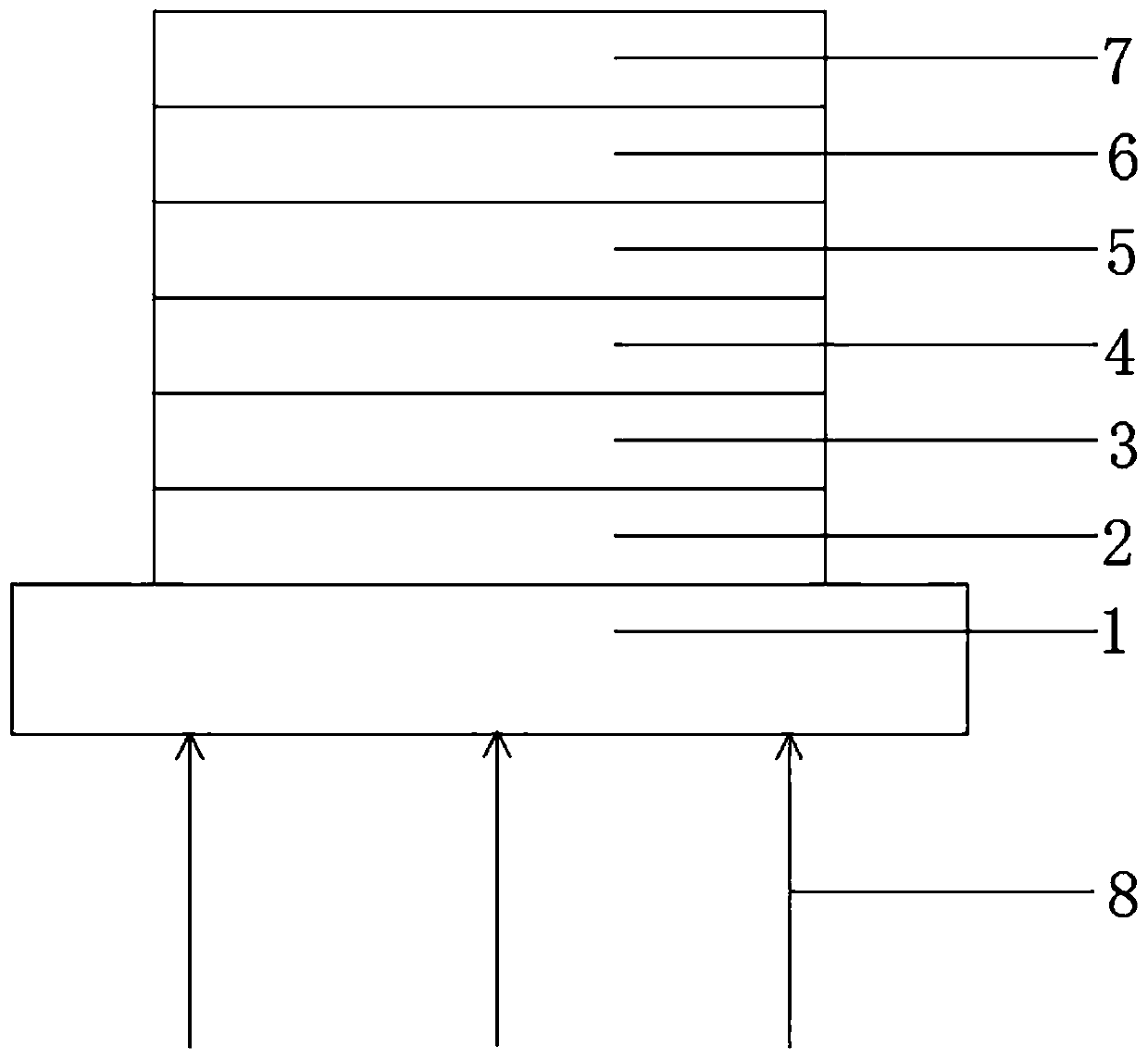Near-infrared flexible detector based on optical microcavity effect and preparation method thereof
An optical microcavity and near-infrared technology, applied in the field of photoelectric detection, can solve the problems of large half-wave peak width, poor detection performance and no dynamic detection capability, and achieve the effect of small composite loss and improved detection performance.
- Summary
- Abstract
- Description
- Claims
- Application Information
AI Technical Summary
Problems solved by technology
Method used
Image
Examples
Embodiment 1
[0038] A near-infrared flexible detector based on the optical microcavity effect, including a glass substrate 1, a flexible substrate 2 is attached to the glass substrate 1, a transparent conductive electrode ITO3 is plated on the flexible substrate 2, and the transparent conductive electrode ITO3 An electron transport layer 4 , an organic functional layer 5 , and a hole transport layer 6 are spin-coated sequentially from bottom to top, and a metal electrode layer 7 is plated on the hole transport layer 6 .
[0039] Wherein, the flexible substrate 2 is PET.
[0040] The translucent conductive electrode ITO3 is an Au conductive electrode with a thickness of 30 nm.
[0041] The electron transport layer 4 adopts PEIE with a thickness of 10 nm.
[0042] The organic functional layer 5 adopts a PBTTT:PCBM bulk heterojunction with a thickness of 150 nm.
[0043] The hole transport layer 6 adopts MnO with a thickness of 10nm 3 film.
[0044] The metal electrode layer 7 is a silver...
Embodiment 2
[0054] On the basis of Embodiment 1, the difference between this embodiment and Embodiment 1 is that the organic functional layer 5 is replaced by P3HT:PCBM.
[0055] Before the test, the flexible substrate 2PET and the film on it are removed from the glass substrate 1 to obtain a bendable flexible detector. Under standard test conditions, the light beam is extracted from the light source, and the incident light 8 is vertically incident on the flexible flexible detector. The test result shows that when the flexible substrate 2 is properly bent, the radius of curvature is 14 cm, and the organic functional layer 5 is about 130 nm. The test results show that the perovskite photodetector has a near-infrared narrow-band detection capability at 780nm, and its detection rate is 8.2-10 12 Jones, the half-wave peak width is 26nm.
Embodiment 3
[0057] On the basis of Embodiment 1, the difference between this embodiment and Embodiment 1 is that the bendable flexible substrate 2PET is replaced by a stretchable flexible substrate 2VHB.
[0058] Before the test, the flexible substrate 2VHB and the film on it are removed from the glass substrate 1 to obtain a stretchable flexible detector. Under standard test conditions, the light beam is drawn from the light source, and the incident light 8 is vertically incident on the flexible flexible detector. The test result shows that when the flexible substrate 2 is properly stretched, the organic functional layer 5 is about 135 nm, and the test result is that it can The curved flexible detector has near-infrared narrow-band detection capability at 780nm, and its detection rate is 8.2-10 12 Jones, the half-wave peak width is 31nm.
PUM
| Property | Measurement | Unit |
|---|---|---|
| Thickness | aaaaa | aaaaa |
| Thickness | aaaaa | aaaaa |
| Thickness | aaaaa | aaaaa |
Abstract
Description
Claims
Application Information
 Login to View More
Login to View More - R&D
- Intellectual Property
- Life Sciences
- Materials
- Tech Scout
- Unparalleled Data Quality
- Higher Quality Content
- 60% Fewer Hallucinations
Browse by: Latest US Patents, China's latest patents, Technical Efficacy Thesaurus, Application Domain, Technology Topic, Popular Technical Reports.
© 2025 PatSnap. All rights reserved.Legal|Privacy policy|Modern Slavery Act Transparency Statement|Sitemap|About US| Contact US: help@patsnap.com

